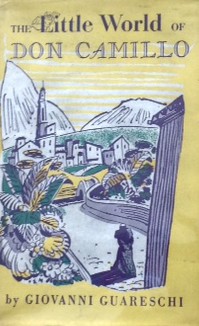Inspiring Older Readers
 posted on 15 Jul 2016
posted on 15 Jul 2016
The Little World of Don Camillo by Giovani Guareschi
Not too long ago I found myself puzzling over what had made Italians turn to fascism during the years before the outbreak of World War Two. The story of Germany's embracing of Hitler and the Nazis is well documented but, quite often, Italy and its time under Mussolini is treated as if it were some kind of dangerous joke. So, I was intrigued to discover that many of the same things that had scarred post-First World War German politics pertained to Italy too. They also harboured a sense of peace treaty shame, suffered rampant inflation and had to deal with political schism between left and right. The rise of an influential Communist Party after 1920 also clashed with an establishment based around the Catholic Church and a monarchy fighting for its very life.
All this digging around in Italian history reminded me that I had a copy of Giovani Guaresci's classic, The Little World of Don Camillo, that I'd never got around to reading. I had heard this collection of what is, in effect, short tales being read on BBC radio and they were, as I remembered, whimsical and amusing but with an edge of political conflict about them. The first edition published in 1951 that I found cheaply in a charity shop is also an attractive thing in terms of design and is decorated with a series of little chapter-head illustrations by the author. I didn't dash to read the book when I bought it because when I did a bit of research on Guareschi I thought his profile was problematic. He fought in the war as part of the Italian army and spent time as a prisoner of war both of the Germans and the Allies but he retained essentially monarchist sympathies after the war when the Republic replaced the royal family in Italy. Returning to his original occupation as a journalist and magazine humourist he became famous for lampooning communism - creating characters that ridculed the leadership of the party. So, I figured, it was clear to see where his sympathies lay. Interestingly, he prefaces this book with a short biographical essay in which quite a lot of this background is explained.
The stories that make up this collection centre on the fractious - and frequently farcical - relationship between Don Camillo, a priest, and Peppone, a Communist and elected Mayor of a small village based on the author's home territory somewhere on the plain of the River Po not far from Parma. Twenty or so short chapters, each virtually self-sufficient as a story, see Don Camillo and Peppone not just clashing ideologically or spirtually but resorting quite frequently to physical violence. Constantly in the background - and maybe just in the head of the priest - is the voice of the Lord constantly acting as a mediator or voice of reason. A voice that tends, however, to tip the balance of the moral advantage always towards Don Camillo. It doesn't take long to spot that the voice of the Lord is really the voice of the author butting into the world he has created.
In literary terms this book is really just a bit of fluff. However, put in its historical context it becomes so much more fascinating. The drama of Italian politics, in a constant state of flux between the dominant Christian Democratic Party, the Communist Party and the Catholic Church, is played out here in these slight domestic, spiritual and political dramas. There is clearly a moving spirit behind these tales that is essentially antagonistic towards communism but to see it as crude, right wing propaganda would be to do it an injustice. Don Camillo and the church as an institution get plenty of stick too and I think Guareschi would argue that his job was not to be overtly partisan but, more importantly, to lay bare human folly.
Terry Potter
July 2016